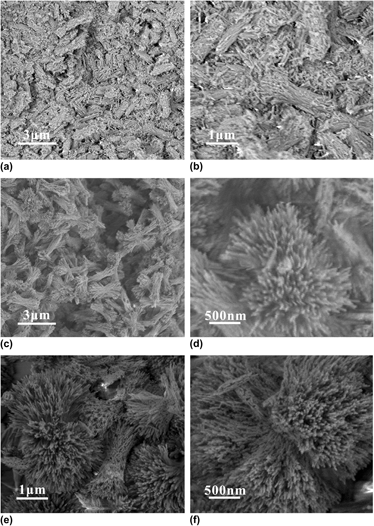Crossref Citations
This article has been cited by the following publications. This list is generated based on data provided by
Crossref.
Pei, L. Z.
Pei, Y. Q.
Xie, Y. K.
Fan, C. G.
and
Zhang, Q. F.
2013.
Formation mechanism of manganese vanadate microtubes and their electrochemical sensing properties.
International Journal of Materials Research,
Vol. 104,
Issue. 12,
p.
1267.
Pei, Lizhai
Lin, Nan
Wei, Tian
Liu, Handing
and
Yu, Haiyun
2015.
Formation of copper vanadate nanobelts and their electrochemical behaviors for the determination of ascorbic acid.
Journal of Materials Chemistry A,
Vol. 3,
Issue. 6,
p.
2690.
Pei, L.Z.
Wei, T.
Lin, N.
Fan, C.G.
and
Yang, Zao
2016.
Aluminium bismuthate nanorods and the electrochemical performance for detection of tartaric acid.
Journal of Alloys and Compounds,
Vol. 679,
Issue. ,
p.
39.
Pei, L.Z.
Wei, T.
Lin, N.
and
Zhang, H.
2016.
Synthesis of bismuth nickelate nanorods and electrochemical detection of tartaric acid using nanorods modified electrode.
Journal of Alloys and Compounds,
Vol. 663,
Issue. ,
p.
677.
Zeravik, Jiri
Fohlerova, Zdenka
Milovanovic, Miodrag
Kubesa, Ondrej
Zeisbergerova, Marta
Lacina, Karel
Petrovic, Aleksandar
Glatz, Zdenek
and
Skladal, Petr
2016.
Various instrumental approaches for determination of organic acids in wines.
Food Chemistry,
Vol. 194,
Issue. ,
p.
432.
Du, Jing
Zhang, Ting
Xing, Jiale
and
Xu, Cailing
2017.
Hierarchical porous Fe3O4/Co3S4nanosheets as an efficient electrocatalyst for the oxygen evolution reaction.
Journal of Materials Chemistry A,
Vol. 5,
Issue. 19,
p.
9210.
Zhang, Y.
Lin, F.F.
Wei, T.
and
Pei, L.Z.
2017.
Facile synthesis of Cu bismuthate nanosheets and sensitive electrochemical detection of tartaric acid.
Journal of Alloys and Compounds,
Vol. 723,
Issue. ,
p.
1062.
HAN, Gui-hong
YANG, Shu-zhen
HUANG, Yan-fang
YANG, Jing
CHAI, Wen-cui
ZHANG, Rui
and
CHEN, De-liang
2017.
Hydrothermal synthesis and electrochemical sensing properties of copper vanadate nanocrystals with controlled morphologies.
Transactions of Nonferrous Metals Society of China,
Vol. 27,
Issue. 5,
p.
1105.
Gangaiah, Vijayakumar
Adarakatti, Prashanth Shivappa
Siddaramanna, Ashoka
Malingappa, Pandurangappa
and
Chandrappa, Gujjarahalli Thimmanna
2017.
Studies on phase and morphological evolution of silver vanadium oxides as a function of pH: evaluation of electrochemical behavior towards quantification of Pb2+ and Cd2+ ions.
Materials Research Express,
Vol. 4,
Issue. 8,
p.
085039.
Teixeira, Mayara Mondego
de Oliveira, Regiane Cristina
Oliveira, Marisa Carvalho
Pontes Ribeiro, Renan Augusto
de Lazaro, Sergio R.
Li, Máximo Siu
Chiquito, Adenilson J.
Gracia, Lourdes
Andrés, Juan
and
Longo, Elson
2018.
Computational Chemistry Meets Experiments for Explaining the Geometry, Electronic Structure, and Optical Properties of Ca10V6O25.
Inorganic Chemistry,
Vol. 57,
Issue. 24,
p.
15489.
George, Jaise Mariya
Antony, Arun
and
Mathew, Beena
2018.
Metal oxide nanoparticles in electrochemical sensing and biosensing: a review.
Microchimica Acta,
Vol. 185,
Issue. 7,
Lin, F. F.
Wei, T.
An, D. H.
Wang, W. L.
and
Pei, L. Z.
2018.
Li Doped Bismuth Oxide Nanorods for Electrochemical Detection of Tartaric Acid.
Surface Engineering and Applied Electrochemistry,
Vol. 54,
Issue. 2,
p.
142.
Ma, Y.
Qiu, F. L.
Wei, T.
Lin, F. F.
Yan, L.
Wu, H.
Zhang, Y.
Pei, L. Z.
and
Fan, C. G.
2019.
Facile Synthesis of Polyaniline/Bismuth Nickelate Nanorod Composites for Sensitive Tartaric Acid Detection.
Surface Engineering and Applied Electrochemistry,
Vol. 55,
Issue. 3,
p.
335.
Chen, H.J.
Lin, F.F.
Yu, C.H.
Xue, Z.Y.
Wang, Z.
Pei, L.Z.
Wu, H.
Wang, P.X.
Cong, Q.M.
Fan, C.G.
and
Ling, X.Z.
2020.
Polyaniline/Ba bismuthate Nanobelts for Sensitive Electrochemical Detection of Tartaric Acid.
International Journal of Electrochemical Science,
Vol. 15,
Issue. 2,
p.
1742.
Teixeira, Mayara Mondego
Gobato, Yara Galvão
Gracia, Lourdes
da Silva, Luís Fernando
Avansi, Waldir
Assis, Marcelo
de Oliveira, Regiane Cristina
Prando, Gabriela Augusta
Andrés, Juan
and
Longo, Elson
2020.
Towards a white-emitting phosphor Ca10V6O25 based material.
Journal of Luminescence,
Vol. 220,
Issue. ,
p.
116990.
Alagarsamy, Saranvignesh
Mariyappan, Vinitha
Chen, Shen-Ming
sundaresan, Ruspika
Chen, Tse-Wei
Tseng, Tien-Wen
Rwei, Syang-Peng
and
Yu, Jaysan
2022.
Ultrasensitive Electrochemical Sensor for the Detection of Mefenamic Acid Based on Calcium Vanadate Nanofilaments/Reduced Graphene Oxide Nanocomposite.
International Journal of Electrochemical Science,
Vol. 17,
Issue. 6,
p.
220643.
Tao, Feihu
Yu, Chunhu
Huang, Jianfeng
Li, Feiyang
Cai, Zhengyu
Fan, Chuangang
and
Pei, Lizhai
2022.
Synthesis and properties of BiDy composite electrode materials in electrochemical sensors.
Materials Chemistry Frontiers,
Vol. 6,
Issue. 19,
p.
2880.
Xue, Zeyang
Li, Feiyang
Yu, Chunhu
Huang, Jianfeng
Tao, Feihu
Cai, Zhengyu
Zhang, Hui
and
Pei, Lizhai
2022.
Low temperature synthesis of SnSr(OH)6nanoflowers and photocatalytic performance for organic pollutants.
International Journal of Materials Research,
Vol. 113,
Issue. 1,
p.
80.
Huang, Hong-Qi
Li, Yong-Yu
Chen, Shi-Hua
Liu, Zhong-Gang
Cui, Yu-Min
Li, Hui-Quan
Guo, Zheng
and
Huang, Xing-Jiu
2022.
Noble-metal-free Fe3O4/Co3S4 nanosheets with oxygen vacancies as an efficient electrocatalyst for highly sensitive electrochemical detection of As(III).
Analytica Chimica Acta,
Vol. 1189,
Issue. ,
p.
339208.
Huang, Jianfeng
Tao, Feihu
Sun, Zizhan
Li, Feiyang
Cai, Zhengyu
Zhang, Yong
Fan, Chuangang
and
Pei, Lizhai
2022.
A facile synthesis route to BiPr composite nanosheets and sensitive electrochemical detection of l-cysteine.
Microchemical Journal,
Vol. 182,
Issue. ,
p.
107915.



